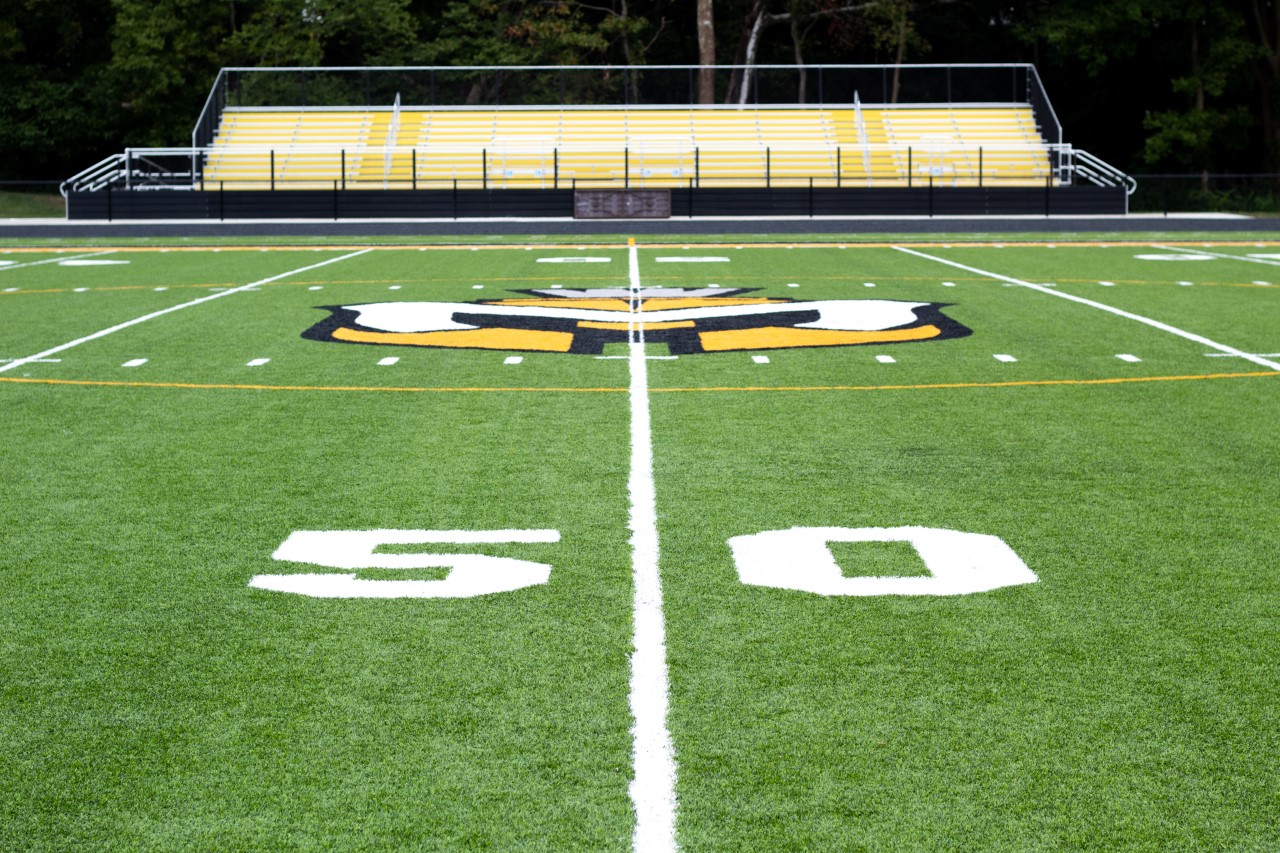 The new grandstand as seen from its position on the 50 yard line awaits students and fans.
The new grandstand as seen from its position on the 50 yard line awaits students and fans.
Photo by TJ Whitmer
New Spartan Stadium Ready for First Events
Mitchell Marks
Manchester University’s athletic department is ready to unveil its new home for the Spartan football, soccer, and track and field teams. The newly constructed Spartan Stadium will host its first competition Sept. 26.
Spartan Stadium is a multipurpose athletic facility featuring a turf football field, a renovated rubber track, LED stadium lighting and a video scoreboard. While the turf and track are already receiving heavy use from athletic practices, the Sept. 26 competition—a cross country meet against conference rival Bluffton University—will be the school’s first chance to showcase the venue on a larger scale.
Construction of the facility began last fall after years of planning, according to Manchester University Athletic Director Rick Espeset. “We have been talking about a new stadium since 2011,” said Espeset, who explained the purpose of building the new stadium was to create a “destination for people” that will enhance the gameday experience for Manchester fans and student athletes.
Espeset is excited for the Manchester community to experience the new venue and anticipates players will respond to the stadium with pride, a sentiment echoed by senior athlete Conner Sherwin. “The new stadium’s amazing,” said Sherwin, a two-sport athlete who will use the new facility as a member of Manchester’s football and track and field teams. “It’s a huge improvement. I think we’re all very excited to play on it.”
Spartan Stadium replaces Carl W. Burt Memorial Stadium, the historic Manchester venue Espeset and Spartan athletes believed was becoming outdated. “The old stadium definitely needed renovation,” Sherwin said. “We were the only school in the conference without a turf field.”
Replacing Burt Stadium’s natural grass football field with artificial turf is one of the main selling points of the new venue, according to Espeset. Senior football player P.J. Smith agreed, explaining that playing on turf is an exciting new addition that will help athletes remain healthy. “Games towards the fall won’t get as mucky as Burt Field,” Smith said. “We won’t slip and slide as often, which will help us avoid injury.
Artificial turf will also increase the amount of time Manchester’s athletic teams are able to use the field throughout the year. Compared to the old grass field, Spartan Stadium’s turf comes with the capability of accommodating events and practices earlier in the spring or later in the fall without dealing with the level of maintenance Burt Stadium required. The facility’s updated LED stadium lights will further enhance its usage and longevity. In addition to football, the turf field will be used for soccer competitions and track and field events.
The stadium’s Olympic-sized track will give Manchester the ability to host larger tournaments and topnotch track and field events, according to Espeset. He hopes this exposure will draw more outside spectators to Manchester and help increase the school’s athletic notoriety.
Spartan Stadium is also equipped with a large video scoreboard that will provide a new way for fans and athletes to experience Manchester athletic events. At football games, for example, the scoreboard will display the name and picture of the Manchester athlete involved in each play. This virtual presentation option represents a unique, eye-catching addition to Spartan competitions that Espeset believes will improve the fan experience.
That connection with fans and the North Manchester community is what Espeset set out to achieve with Spartan Stadium. In Smith’s eyes, at least, the athletic director accomplished his goal. “The scoreboard is going to positively impact the game atmosphere,” Smith said. “It’s going to get the fans more involved, which will help us play better on the field.”
In addition to the benefits the new stadium will provide current Manchester students and fans, Espeset also foresees a boost toward recruiting future Spartan athletes because “facilities are one of the things prospects evaluate” when choosing where to attend school. Espeset expects Spartan Stadium to help attract students to Manchester, an exciting possibility for the athletic director.
Smith shared Espeset’s optimism about the recruiting benefits provided by the new facility, stating that it will be easy to get prospective student athletes to want to play at Spartan Stadium. “Recruits are definitely more likely to come to Manchester now,” the offensive lineman said. “College facilities matter to athletes, and people weren’t excited about playing on Burt Field. Athletes care about what they look like and what they play on.” For Smith and his football teammates, the first opportunity to play an official game on the new field will come Oct. 17 against Adrian College.
While Spartan Stadium will primarily be used as an athletic facility, Espeset does not want to limit the venue to just sports. “Spartan Stadium is a Manchester University space, not just a Manchester athletics space,” said Espeset, who hopes many non-athletic groups of students and community members will use the new facility. Manchester’s exercise science and athletic training departments, for example, will receive valuable experience while utilizing the venue. Espeset is looking forward to this connected Manchester experience and is excited to watch students and community members enjoy the new stadium.
For a tight-knit community like North Manchester, the new facility provides another opportunity for students and residents to interact with each other. This shared experience is an important aspect of Spartan Stadium that will benefit the Manchester community, Sherwin believes. “The new stadium is going to bring the school closer together and really solidify the Manchester culture,” he said. “I think Spartan Stadium is a great addition for the entire Manchester community.”